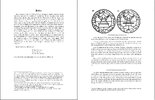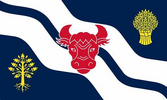That would be Liber Cheth vel Vallum Abiegni Sub figura CLVI.
I don't have the original in English, only the German version by Grosche contained in Gregorius - Aleister Crowley's Magische Rituale. Verlag Richard Schikowski. West-Berlin 1980.
There in the Explanatory notes is written:
The book gives the formula for perfect attainment through the method of worshipping Babalon. It teaches the candidate how to dissolve his personality in the all-embracing life in order to reach a higher stage. It is the highest form of Bhakti-Yoga.
The content is more or less like the Kali poem I posted some pages ago.
It has 22 [!] Stanzas. Here are the first five back-translated to get an idea:
Your detailed knowledge on things pertaining to the occult is valued as ever. I apologise for not responding on your recent posts but I was focused on finishing the article I have just posted. I will try and make time to comment on what you have recently posted, starting now, as it is very interesting.
Based on my knowledge of Aleister Crowley's warped life, he seems to have been intent on helping to usher in the Apocalypse. He also had OTO links with the equally strange Jack Parsons, the American maverick rocket fuel scientist, who carried out a mysterious occult ceremony with the writer and founder of Scientology Ron L Hubbard, which coincided with the Roswell UFO Crash and the start of the modern UFO and alien abduction phenomenon.
We also know that Crowley had links with British Intelligence (M16 etc - see attached article - and seemed to have worked for them as a part time contractor) an organisation which appears to have a particular interest in the Ark/Grail and that region of the Spanish/French Pyrenees where the Grail may be hidden. Recall her that the authors Guy Patton and Robin Mackness, who wrote the book Web of Gold, were made aware of the dangers of conducting research into Rennes-le-Chateau. Quoting from one of my earlier articles - The Chateau of Arginy in France:
"Furthermore, they allege that in 1998, a former British Intelligence officer told a Rennes researcher that he had personally seen a room within the Ministry of Defence in the 1970's dedicated to surveillance of the region of Rennes-le-Chateau. Yet another former Intelligence officer, the late Michael Bentine (better known as a highly successful British comedian - one of the original 'Goons' in the famous 'Goon Show', a radio show that made stars of Peter Sellers, Sir Harry Secombe and Spike Milligan) warned members of the Rennes Research Group on several occasions that investigations into the affair of Rennes-le-Chateau could be dangerous. As the authors state - what did he know?"
Given that the British Secret Service is riddled with Freemasons and no doubt a few Rosicrucians too, the knowledge that the MOD has a room dedicated to Rennes-le-Chateau makes me think of the Enclave of Alchemists in the Pyrenees who seem to be linked with the Rosicrucians and by extension therefore to the Rosteem. Whilst I was writing my last article, I thought about whether the Rosicrucians may have infiltrated the ranks of the Templars, perhaps through the Templar Master of Provence Roncelin de Fos who had also been a Master of the Temple in England before reassuming the role of Master of Provence again. In his confessions, the English Templar Stephen de Staplebridge had intimated that the Order’s errors had originated with de Fos. If so, the Rosicrucians (perhaps manifesting as the original medieval Priory of Sion) had a rough idea of where the Grail had been taken but not exactly where, as borne out by what the C's said here:
Q: (A) Okay. Once it is tuned, it is tuned, right? (R) Yeah. And if it was similar to our simulation then tuning is done by exposing it to similar frequencies. (L) Or maybe assembling it by virtue of frequencies that are produced. But it still needs to be established whether or not they can see it. So we have theorized that the reason they can't find it, the only reason we can see for why they can't find it, is because for some reason it is protected by frequency or something and that they don't know where it is either. Is this correct?
A: Mostly. They have a general idea.
Q: What specifically prevents them from isolating the exact spot and getting it?
A: Occlusion.
Q: (A) What is occlusion? (R) I think that's similar to ...
A: Frequency fence.
Q: (L) We were making some theories about this object that Vincent Bridges was looking for - the Ark of the Covenant, or the Holy Grail. I believe that we understand that this is an object that is of great usefulness, some kind of lensing device. Is that correct?
A: Yes.
Q: (L) Is this something that the STS groups - yeah, we know everybody on earth is STS, but I mean the heavy duty ones - had at one time and then lost, or lost control of?
A: Yes.
Q: (L) How did they lose it?
A: It was not so much "lost" as it was "retrieved" and put away for safe keeping.
Q: (R & L) Who retrieved it?
A: 4th density STO mission.
Q: (L) Who is it that is looking for it? Is it 3rd density STS or 4th density?
A: Both.
The fact that Nicola Poussin, an alleged Rosicrucian, painted a work of art, The Shepherds of Arcadia, which depicted a sepulchre located on the outskirts of the town of Arques with Mt Pech Cardu in the background and other works with the Templar Tour Blanchefort within them, suggests that the Rosicrucians know the Grail is hidden somewhere in the Rennes-le-Chateau area but not exactly where.
So, was Stephen de Staplebridge and his small band of fellow fugitive Templars part of a 4th density STO retrieval mission relating to the Grail?
Returning to Crowley, he seems to have linked the Holy Grail to a sacred vessel linked with the '-jezebel- of Babylon' and the Beast (who Crowley served) of the Apocalypse judging from the poem you posted:
1. This is the secret of the Holy Grail, which is the sacred vessel of our Lady, the Scarlet Woman, Babalon, the Mother of Abominations, the Bride of Chaos, who rides our Lord, the Beast.
This suggests the Grail is linked in Crowley's mind in some way to the Apocalypse (see more below on this) and the ensuing chaos which clearly comes with it - think here of the destruction of Kantek and the part the Grail played in conveying a group of Kantekkians to safety on Earth. This could suggest that the Grail is a device of great power, which may be interpreted by some as something evil, perhaps because it was used in conjunction with the power cell that the C's said lay behind the Ark of the Covenant's great powers of death and destruction. The notion that the Grail is a device of great power that is linked with evil is reflected in what the C's said here:
Session 26 February 2002:
Q: (L) Jay Weidner says that there is something in the south of France that is very, very evil. Is correct in this assessment?
A: Not really. But those guarding the secrets might be termed as such. Also they wish to make others think thus. Machiavelli!
Machiavelli was renowned for promoting the tactic of imputing to your enemies that which you yourself were thinking in order to paint them in a bad light and promote yourself as the good guy. I can't help thinking that the C's had the Rosicrucian inner circle and the Illuminati (the upper echelons of Freemasonry) in mind here when they said this. I have previously mentioned that the Rosicrucians are one of those organisations who are desperately keen to lay their hands on the Grail. Think here of what I said about the Rosicrucian Grand Master Jean Cocteau and his interest in the Tour Girona where he felt the Grail may have been hidden. The tower was subsequently taken down stone by stone by unknown forces just as the Church of St John at Rennes-le-Chateau had been six hundred years earlier, no doubt for the same reason, i.e., to find the Grail. Let us also not forget Andrew Gough's tale of a Rosicrucian led seabed hunt for something described as 'the Beloved' off the coast of Oak Island in Nova Scotia.
As I said in my article, I found it disconcerting that Richard Ward and Andrew Collins relied to a great extent on the spirit of Aleister Crowley to help locate the strange key which they eventually found at a church located near St. Margaret's Well at Binsey in Oxfordshire, which Collins believes lies at the sacred centre of England - a well linked with the Anglo-Saxon Saint Frideswide. Collins seems more heavily mixed up in the occult than he would have us believe. I had to shorten my article as I wanted it to be primarily focused on the Knights Templar and the Grail. However, there were other aspects of Collins' account that link with things the C's have told us about. This includes a mysterious group based at a castle (perhaps the Chateau at Arques), which he called the Faceless Ones, who may well have been 4th density beings and possibly even the Quorum. He also claimed to have had an encounter with Saint Frideswide (a Saxon Princess) at St Margaret's Well shortly before he, his wife Sue and Richard Ward found the mysterious key. The meeting did not go well as you can judge from this extract:
"Richard said she seemed displeased: "I cannot help you", she began, standing by the well again with the pigs around her. "You have given yourself over to the darkness. The Faceless Ones control you. Do you want to step into the light?"
We wished only to find the key.
"The key is not with me."
We were told we could have it.
"The key is damnation", she broke in. "The opening of the pit. They want to release him. The thing they call Abaddon."
We needed the key to better understand the Holy Grail and not to bring about some apocalypse.
"The key is not with me. It is with him."
She meant Crowley.
"It has been taken from me."
But if she was willing to give it to us in the first place, then it must be all right for us to pursue the key, meaning that its removal was not all doom and gloom doom.
Richard then said: "This is very odd. It's like the key has now changed. It's hard to explain it. IT's like two keys in one. although they are on split levels - we can have either one, although one form represents the light and the other darkness. It relates in some way to two possible paths into the future - one Christian and the other not, as well as the light and the darkness contained in the Marian Chalice [MJF: the Grail?] itself. Yet the final decision is ours."
Richard had implied there might be two keys during the last session, although he was implying now was that there were two forms of the same key. Was that right?
"It's all going to be down to an interpretation of the symbols on the key", he explained, having now come out of the meditational state. "The key which she would have give us has different symbols to the one Crowley will present to us. "It's all to do with split decisions and linear possibilities, which we can still jump between at this stage, although everything will become certain, fixed, once the choice is made and the path taken."
Collins wife favoured the Crowley path as he had been their guide all along. However, Richard Ward was less sure. He said "Well, Crowley's been the overshadowing presence to me for a long time. Yet I feel we are being pushed towards making a decision."
Ward admitted at this point that it was almost as if Saint Frideswide had known we were going to make the choice we did, even before the matter had cropped up. He felt that there were forces working with Crowley, and forces working with her - each of them trying to steer us on to a different path, which would ultimately lead to the same destination - truth and enlightenment
I shall leave it to the reader to decide what they think about Collins' choice. For myself, I am left concerned that he and his companions chose to go with Crowley as their guide, given the man's notorious libidinous lifestyle and occult dabbling's. Crowley is clearly linked with the dark path. His motto was "do as thou wilt". However, when it comes to the mysterious Faceless Ones, it seems Crowley couldn't just do as he liked at 5th density, as he had to answer to greater powers. This was evident when he admitted to having been overruled on a matter concerning the quest pertaining to Collins and Ward. Who these greater powers might be could have been signalled in an event that occurred soon after Collins and his companions set off from St Margaret's Well after their meeting with Saint Frideswide. Whilst driving to the church at Binsey, they ran into a mysterious localised fog bank, which engulfed their motor car and prevented them from seeing anything beyond it. Collins described it as an ethereal blanket which lingered in the road blotting out the surrounding landscape. Collins had earlier remarked that they would encounter Abaddon in the form of an intelligent mist. When he concentrated his mind, he saw within the fog an orange glowing ball, like an eye, representing some kind of window on to our world.
I find this most curious since Collins' reference to an orange or red glowing ball, which he felt was like some kind of window on to our world, speaks to me of 4th density. This point reminds me of what the C's said here about ball lightning:
(Ark) Let me take opportunity to ask about ball lightning. Are they purely electric phenomena, or are they also related to consciousness or...?
A: Transdimensional portals made manifest.
Does this suggest that 'Abaddon' (the Angel of the Pit) is really just a cypher for 4th density STS underground forces (the Orions, Lizzies etc.) who are about to be unleashed on an unsuspecting world as the Apocalypse unfolds?

de.wikipedia.org




 .
.